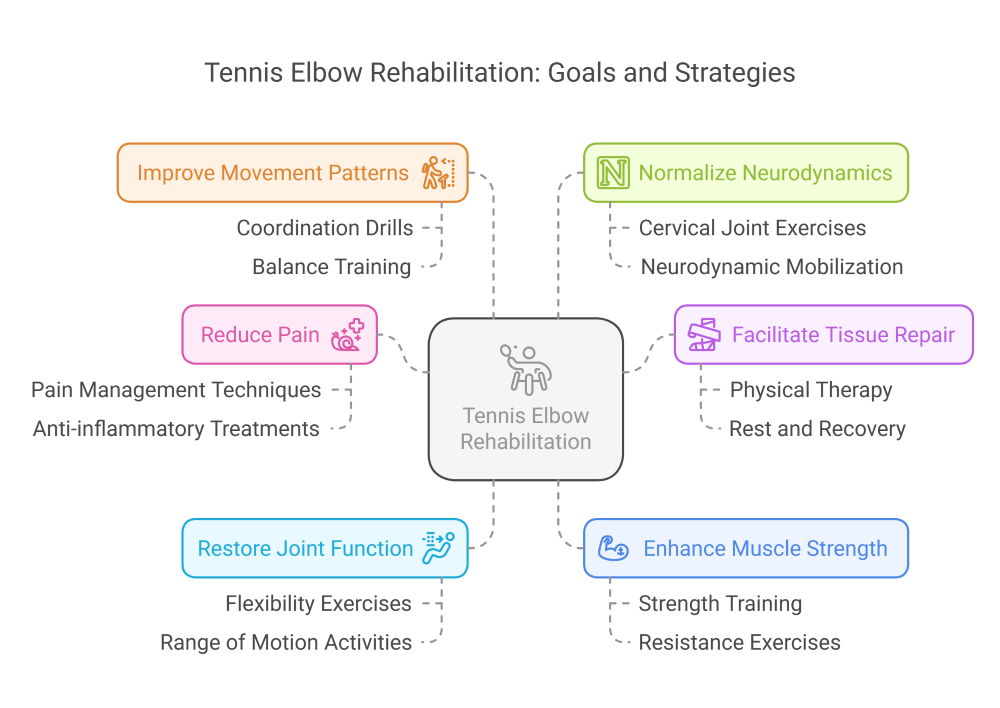Did you know? Tennis elbow isn’t necessarily caused by the eponymous sport. Any repetitive activity or direct injury to the elbows can weaken the tendons linking your forearm muscles to your bones and cause them to swell. Tennis elbow rehabilitation uses different soft tissue techniques, mobilizations, and preventative exercises, to target the pain and limit further flare-ups.
Lateral epicondylitis, more commonly known as tennis elbow, is a tendinopathy injury, which involves your forearm’s extensor muscles. The extensor muscles are located on the distal humerus’ lateral epicondylar area. In most instances, it involves the insertion of the extensor carpi radialis brevis.
Your elbow joint contains three bones, the humerus or upper arm bone, the radius, and ulna. The radius and ulna are located in your forearm. At the humerus’ distal end, you have two epicondyles, one lateral, or on the exterior, and one medial, or on the interior.
The most tender region is usually just below the location of your extensor muscles in your foreman found at the lateral epicondyle. Most commonly, it involves the extensor carpi radialis brevis (ECRB), but others that are involved include the extensor carpi radialis longus (ECRL), extensor digitorum, and extensor carpi ulnaris. The radial nerve is located near this area as well and separates into the posterior interosseous nerve and superficial radial nerve.
The most common cause of tennis elbow is overloading these tendons, which places stress on these tendons near where they attach to the humerus. Continuous and repetitive activities, such as repeat vibration, tension, and forceful forearm supination and pronation, can cause tennis elbow.
Symptoms of Tennis Elbow
The symptoms of include:
- Tenderness on the outside of your elbow
- Waking up with a stiff elbow with continuous pain
- Sore forearm muscles
- Pain with grasping, manipulating and holding objects
Causes of Tennis Elbow
The causes of tennis elbow include:
- Continuous wrist movements (tennis, baseball, badminton, swimming, field throwing sports, and squash, desk job, heavy lifting, carpenter, electrician, gardener, field throwing sports, and continuous use of a computer)
- Movements that require constant squeezing and gripping
- The following maneuvers in tennis can cause tennis elbow
- Late forehand swing causing you to bend your wrist significantly
- One-handed backhand with poor technique or form with wrist extension
- Turning and snapping the wrist while serving the ball with full power
Tennis Elbow Diagnosis
Specialized Physical Therapy can determine whether you have acute or chronic tennis elbow by performing a comprehensive physical examination. Acute tennis elbow is due to damaged muscle tissue, which occurs when you apply increased force to an area. Chronic tennis elbow is due to degenerative changes in your muscle tissues found at the epicondyle.
Our physical therapists will ask you several questions regarding your medical history and injury as part of the tennis elbow diagnosis. We will ask you about your activity level, recreational sports participation, occupation risk facts, medication, and other medical conditions. It is essential to understand the activities causing the symptoms of tennis elbow and the location on your arm where you are experiencing them when creating a tennis elbow rehabilitation plan.
Tennis Elbow Physical Therapy Treatment
Specialized Physical Therapy will develop a tennis elbow rehabilitation Home Exercise Program (HEP) tailored to include exercises to help you regain movement in your elbow, reduce the symptoms, and prevent the pain from returning. We will create a tennis elbow rehabilitation program based on various factors, such as your medical history, age, lifestyle, diet, recreational activities, and type of pain.
Tennis elbow rehabilitation aims to:
- Reduce elbow pain
- Facilitate tissue repair
- Restore normal joint range of movement and function
- Restore normal muscle strength
- Improve movement patterns
- Normalize upper limb neurodynamics and cervical joint function.
Failure to treat tennis elbow can cause continuous pain for six months or longer. Even if the pain stops, chances of reoccurring pain can increase significantly without the proper treatment.
After two to three weeks of physical therapy, you should notice some improvement in your injury. With the use of deep tissue massage, Kinesio Taping, Graston Technique, and other manual treatments, our physical therapists can help return you to proper form.
Outside of the clinic, a Home Exercise Program will be reviewed and given to ensure you have the proper tennis elbow physical therapy tools to improve your condition.

Get in touch with us today to begin your Tennis Elbow Therapy. We are conveniently located in Fair Lawn, NJ. Call us at 201-773-8851 or contact us to schedule appointment.

